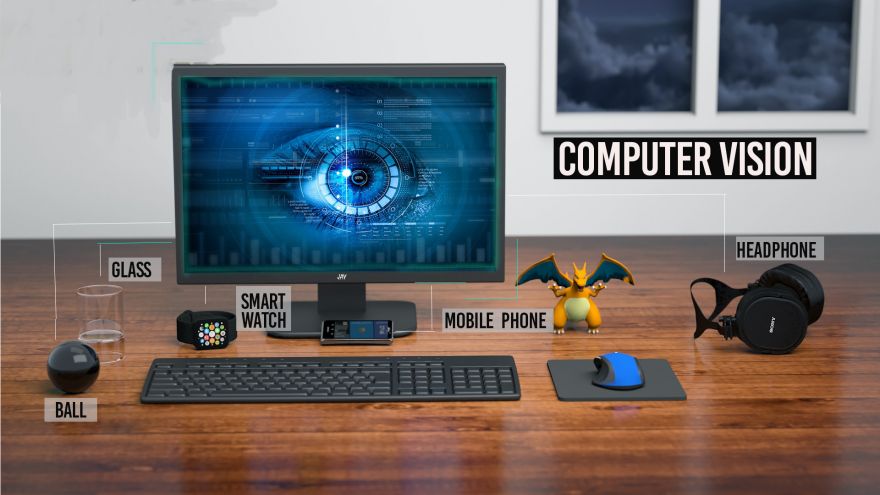
Computer Vision
Computer Vision
Computer Vision has a dual aim. From the biological information time of aspect, computer vision aims to come up with computational models of the human visual shape. From the engineering decimal point of view, computer vision aims to place up autonomous systems which could move out some of the tasks which the human visual system can conduct (and even surpass it often). Many vision tasks are associated with the extrication of 3D and terrestrial data from period-varying 2D details such as obtained by one or more television cameras, and more generally the understanding of such dynamical scenes. Of course, the two goals are associated. The properties and characteristics of the human visual structure often deliver revelation to engineers who are calculating computer vision systems. Computer vision algorithms can make available insights into how the human visual system works.
Computer Vision, or CV for slight, is a theoretical term that describes the aptitude of a machine to get and analyze visual data on its own, and then construct decisions about it. That can subsume photos and videos, but more might include “images” from the thermal, or infrared sensor, detectors, and other sources. The CV is already in use for some purposes, but on the consumer level, it is already relied upon by remote control drones to keep off obstacles, as well as by cars from Tesla and Volvo, among others.
How it’s see
Reinventing the optic is the area where we’ve had the most success. Over the past few decades, we have created sensors and picture processors that match and in some ways beat the human eye’s capabilities. With larger, more complete lenses and semiconductor subpixels fabricated at nanometer scales, the exactitude and sensitivity of current cameras is nothing slight of incredible. Cameras can also write down thousands of images per second and detect distances with large correctness.
Yet despite the high fidelity of their outputs, these devices are in many ways no better than a pinhole camera from the 19th century: They record the assignment of photons coming in a given directing. The best camera sensor ever made couldn’t detect a ball — much less be able to seize it.
The hardware, in other words, is limited without the software — which, it turns out, is by far the greater difficulty to solve. But the latest camera technology does accommodate a wealthy and flexible platform on which to effort.
How do Computer Vision works?
The goal of Computer Vision is to emulate human vision using digital images through three main processing components, executed one after the other:
1. Image acquisition
2. Image processing
3. Image analysis and understanding
On a certain level, CV is all about model recognition. So one way to train a computer how to grasp visual data is to provision it images, lots of images—thousands, millions if possible—that have been labeled, and then subject-matter those to various software techniques, or algorithms, that allow the computer to trail down patterns in all the elements that associate to those labels. So, for example, if you feed a computer a million images of penguins, it will subject-matter them all to algorithms that let them analyze the colors in the photo, the shapes, the distances between the shapes, where objects edge each other, and so on, so that it identifies a profile of what “penguin” means. When it’s finished, the computer will (in theory) be able to use its experience if fed other unlabeled images to find the ones that are of penguins.
Why is Computer Vision difficult?
Computer Vision as a land of research is hard. Almost no exploration problem has been solved. One primary reason for this difficulty is that the human visual system is too acceptable for many tasks (e.g., face recognition), so that computer vision systems suffer by contrast. A human can recognize faces under all kinds of variations in illumination, the point of view, verbalization, etc. In most cases, we have no difficulty in recognizing a friend in a photograph taken many years ago. Also, there appears to be no limit on how many faces we can accumulate in our brains for future recognition. There appears no desire to structure an autonomous system with such stellar execution. Two main related difficulties in computer vision can be identified:
1. How do we distill and represent the infinite amount of human knowledge in a computer in such a way that retrieval is simple?
2. How do we convey out (in both hardware and software) the infinite amount of computation that is often required in such a way that the assignment (such as face recognition) can be done in real period?
Describe
This isn’t the location for an intact course on visual neuroanatomy, but suffice it to say that our brains are built from the ground up with seeing in mind, so to converse. More of the brain is dedicated to eyesight than any other task, and that specialization goes all the way down to the cells themselves. Billions of them labor together to withdraw patterns from the noisy, disorganized signal from the retina.
Sets of neurons excite one another if there’s compare along a line at a certain intersection, say, or rapid motion in a certain directing. Higher-level networks total these patterns into meta-patterns: a circle, moving upwards. Another network chimes in the circle are white, with red lines. Another: it is growing in size. A representation begins to appear from these unrefined but complementary descriptions.
Early research into computer vision, considering these networks as being complex, took a different approach: “top-down” reasoning — a book looks like /this/, so watch for /this/ pattern, unless it’s on its side, in which case it looks more like /this/. A car looks like /this/ and moves like /this/.
To understand
Of course, you could build a system that recognizes every diversity of apple, from every angle, in any situation, at repose or in motion, with bites taken out of it, anything — and it wouldn’t be able to identify an orange. For that issue, it couldn’t even tell you what an apple is, whether it’s edible, how large it is or what they’re used for.
The problem is that even acceptable hardware and software aren’t much use without an operating system. For us, that’s the rest of our minds: little and long-term memory, input from our other senses, attention, and cognition, a billion lessons learned from a trillion interactions with the world, written with methods we understand to a network of interconnected neurons more complex than anything we’ve ever encountered.
This is where the frontiers of computer science and more common artificial intelligence come — and where we’re currently spinning our wheels. Between computer scientists, engineers, psychologists, neuroscientists and philosophers, we can come up with a working delineation of how our minds work, much less how to simulate it.
That doesn’t mean we’re at a dead end. The future of computer vision is in integrating the forceful but specific systems we’ve created with broader ones that are focused on concepts that are a scrap harder to pin down: context, attention, intention.
That said, computer vision even in its nascent grade is still useful. It’s in our cameras, recognizing faces and smiles. It’s in self-driving cars, reading traffic signs and watching for pedestrians. It’s in factory robots, monitoring for problems and navigating around human co-workers. There’s still an extended way to go before they see as we do — if it’s even possible — but considering the scale of the task at hand, it’s wonderful that they see at all.

